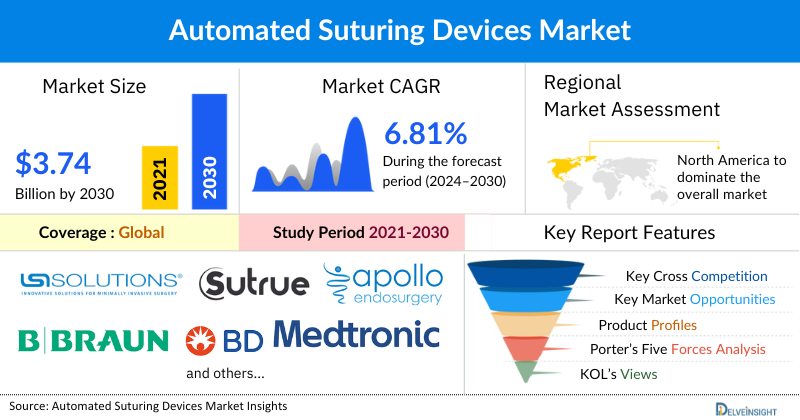Automated Suturing Devices Market
Automated Suturing Devices By Product Type (Disposable And Reusable), By Application (Cardiovascular, Gynecological, Gastrointestinal, Orthopedic, And Others), By End-User (Hospital & Clinics, Ambulatory Surgical Centers, And Others) and by geography is expected to grow at a steady CAGR forecast till 2030 owing to the increasing number of surgeries and increasing figures of injuries and trauma cases worldwide
The global automated suturing devices market was valued at USD 2.53 billion in 2023, growing at a CAGR of 6.81% during the forecast period from 2024 to 2030 to reach USD 3.74 billion by 2030. The automated suturing devices market is witnessing positive growth owing to various factors such as the rising number of surgeries, surging prevalence of chronic disorders, and escalating burden of geriatric patients. Further, increasing cases of accidents, trauma, injuries and an increase in the application of disposable automated suturing devices in the healthcare industry will also contribute to the growth of automated suturing devices market. Furthermore, an increasing regulatory approvals across the globe will further increase the overall growth of the automated suturing devices market. Therefore, the market for automated suturing devices is estimated to grow at a significant CAGR during the forecast period from 2024 to 2030.
Automated Suturing Devices Market Dynamics:
One of the main driver for the automated suturing devices market is the increasing figures of cancer across the globe due to the rising sedentary and unhealthy lifestyle, gene mutations, increasing exposure to smoking, alcohol, carcinogenic substances, among others.
For instance, the World Health Organization (WHO) 2022, presented the data of incidence of various cancer. In 2020, nearly 2.26 million new cases of breast cancer were diagnosed followed by 2.21 million cases of lung cancer, 1.93 million cases of colon and rectum cancer, 1.41 million cases of prostate cancer, 1.20 million cases of skin cancer, and lastly nearly 1.09 million cases of stomach cancer. The increasing incidence of cancers will increase the number of surgical procedures which will aid in the management and treatment of the cancers. The increasing number of surgical procedures will increase the demand of automated suturing devices as the suturing devices are used to facilitate the suturing procedures during a surgery.
Further, as per the World Health Organization (WHO) 2022, it was stated that between 20 and 50 million more people suffer from non-fatal injuries, with many incurring a disability as a result of their injury. Also, the increasing number of accidents will also promote the demand of automated suturing devices owing to the increasing number of surgical procedures. Additionally, according to the International Labour Organization 2022, every year there are around 340 million occupational accidents and 160 million victims of work-related illnesses annually, worldwide. The increasing number of accidents will increase the number of surgical procedures ultimately increasing the demand of automated suturing devices.
Therefore, the factors stated above collectively will drive the overall market of automated suturing devices during the forecast period from 2024-2030.
However, reduced product availability, lack of skilled professionals, high cost of the devices, and other related factors, can hinder the global automated suturing devices market growth.
The COVID-19 pandemic has slightly impacted the market for automated suturing devices. The outbreak of the pandemic led to the cancellation of outpatient visits and the suspension of non-emergency hospitals and surgical procedures for chronic disorders such as cancers, diabetes, cardiovascular disorders, and others. This resulted in the reduced number of surgical operations, thereby reducing the demand of automated suturing devices. However, vaccine development of COVID-19 has produced the process of economic recovery with the easing of the lockdown restrictions and the return of normalcy in the economic landscape which has initiated the process of resumption of regular healthcare services and surgical procedures for the treatment and management of the afore-mentioned diseases ultimately increasing the demand of automated suturing device, thereby bringing the demand for device on track in the automated suturing devices market.
Automated Suturing Devices Market Segment Analysis:
Automated Suturing Devices by Product Type (Disposable and Reusable), Application (Cardiovascular, Gynecological, Gastrointestinal, Orthopedic, and Others), End-User (Hospital & Clinics, Ambulatory Surgical Centers, and Others), and Geography (North America, Europe, Asia-Pacific, and Rest of the World)
In the application segment of the automated suturing devices, the gynecological market is expected to have a significant revenue share in the year 2021. This was primarily owing to the increasing incidence of various gynecological cancers and other gynecological disorders which require an open or non-invasive surgery .
Futher, according to the World Health Organization (WHO) 2022, cervical cancer is the fourth most common cancer among women globally, with an estimated 604,000 new cases and 342,000 deaths in 2020. As per World Cancer Research Fund International 2020, there were more than 313,000 new cases of ovarian cancer in 2020, globally. Also, American Cancer Society 2022, estimated that in the United States, about 19,880 women will receive a new diagnosis of ovarian cancer and about 12,810 women will die from ovarian cancer, in 2022.
Additionally, the World Cancer Research Fund International in 2020 concluded the number of new cases of endometrial also known as womb or corpus uteri cancer. The source stated that, there were more than 417,000 new cases of endometrial cancer in 2020.
Therefore, all the above statistics from the different sources clearly stated that the incidence of various type of gynecological cancer is increasing globally. The increasing incidence of cancers will increase the number of surgical procedures used for the treatment and management of the cancer, ultimately increasing the demand of automated suturing devices, which aid in suturing of the cuts during a surgical procedure.
Furthermore, the increasing prevalence of vaginal, vulvar cancer, endometriosis, fibroids, ovarian cysts, chronic pelvic pain, pelvic inflammatory disease, uterine prolapse or abnormal bleeding, and other gynecological disorders will also drive the market of automated suturing devices in the gynecological segment.
Thus, the increasing incidence of the gynecological cancers across the globe will in turn drive the gynecological segment market in automated suturing devices market, thereby propelling the overall market growth of automated suturing devices in the forecast period from 2022 - 2030.
North America is expected to dominate the overall Automated Suturing Devices Market:
Among all the regions, North America is expected to dominate the global automated suturing devices in the year 2021 and is expected to do the same during the forecast period from 2024-2030. Factors such as the rising number of surgeries, surging prevalence of chronic disorders, escalating burden of geriatric patients, and others will increase the demand for automated suturing devices in North America, leading to a rise in the overall automated suturing devices market growth.
For instance, according to the National Safety Council, 2021, in 2020 the United States experienced nearly 55.4 million injuries due to motor vehicles. The increasing number of injuries will increase the number of surgical procedure, eventually increasing the demand of automated suturing devices.
Further, as per WHO 2021, more than 13 million US surgical procedures were performed from January 1, 2019, to January 30, 2021. Thus, the increasing figures of surgical procedures will increase the demand of automated suturing devices.
Additionally, the Centre for Disease Control and Prevention (CDC) 2022, nearly 6 in 10 adults in the United States have chronic disorder and 4 in 10 adults have two or more chronic disease at one duration of time. The rising number of chronic disorders will increase the number of surgical procedure, thereby propelling the demand of automated suturing devices.
Therefore, the increasing use of reusable suturing devices in several surgeries, rising number of heart surgeries, increasing number of road accidents and trauma cases, increasing geriatric population base coupled with rising number of surgical procedures among others will boost the market growth of automated suturing devices across the North America, thereby propelling the overall market growth during the forecast period during 2022 – 2030.
Automated Suturing Devices Key Players:
Some of the key market players operating in the automated suturing devices include Medtronic, LSI Solutions, Inc., Sutrue Limited, Apollo Endosurgery, Inc., B. Braun Melsungen AG, Becton, Dickinson & Company, Ethicon, Inc. (Johnson & Johnson), Smith & Nephew, Inc., EndoEvolution, LLC., Mellon Medical B.V., Endo Tools Therapeutics, MyEllevate® Surgical Suture System, EDGe Surgical., MEDICAL MICROINSTRUMENTS, INC., SuturTek Inc., and others.
Recent Developmental Activities in the Automated Suturing Devices Market:
- In January 2022, Endomina, an endoscopic medical suture device developed an Endo Tools Therapeutics, that was approved by the United States Food and Drug Administration for endoscopic placement of sutures in the gastrointestinal tract in the adult population.
- In July 2021, Anchora Medical, an Israel-based medical device company, announced that it has received 510(k) clearance from the United States Food and Drug Administration (FDA) to market its Su2ura® Approximation Device, an innovative, automated suturing device used in laparoscopic surgery, for the placement of interrupted or running stitches in soft tissue.
Key Takeaways from the Automated Suturing Devices Report Study
- Market size analysis for current automated suturing devices (2023), and market forecast for 5 years (2024-2030)
- The effect of the COVID-19 pandemic on this market is significant. To capture and analyze suitable indicators, our experts are closely watching the automated suturing devices market
- Top key product/services/technology developments, mergers, acquisitions, partnerships, and joint ventures happened over the last 3 years
- Key companies dominating the global automated suturing devices
- Various opportunities are available for the other competitor in the automated suturing devices market space.
- What are the top-performing segments in 2023? How these segments will perform in 2030.
- Which are the top-performing regions and countries in the current automated suturing devices market scenario?
- Which are the regions and countries where companies should have concentrated on opportunities for automated suturing devices growth in the coming future?
Target Audience who can be benefited from this Automated Suturing Devices Market Report Study
- Automated suturing devices providers
- Research organizations and consulting companies
- Automated suturing devices -related organizations, associations, forums, and other alliances
- Government and corporate offices
- Start-up companies, venture capitalists, and private equity firms
- Distributors and traders dealing in Automated suturing devices
- Various end-users who want to know more about the automated suturing devices market and the latest technological developments in the automated suturing devices market

